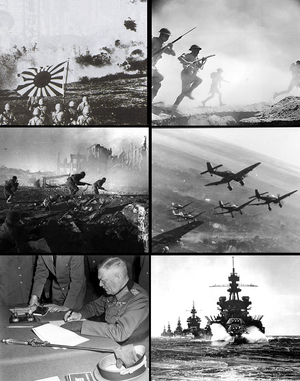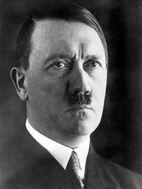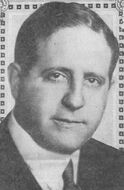User:United Republic/Sandbox/Blood and Soil
Jump to navigation
Jump to search
Timeline A[edit | edit source]
|
| |||||||||||||||||
| |||||||||||||||||
|
| |||||||||||||||||
| |||||||||||||||||
- 1888 – Despondent after the death of their newborn son, Otto, Alois and Klara Hitler decide to move to the United States. The family settles in Little Germany, New York City. Klara is unknowingly a month pregnant before leaving Austria-Hungary.
- 1889 – Klara gives birth to another son, Arnold Alois Hitler. Arnold manages to live longer than their previous sons.
- 1906 – Arnold Hitler is admitted to Harvard Law School following his good performance in high school.
- 1910 – Hitler graduates from Harvard and begins his brief legal career in his home city.
- 1912 – Arnold Hitler meets newspaper mogul and leader of the progressive Democrats William Randolph Hearst. Hearst and Hitler become friends and Hitler subsequently develops an interest in politics. Hitler casts his first presidential vote for Woodrow Wilson.
- 1913 – Despite being a Democrat, Hitler works as an advisor for John Purroy Mitchel's mayoral campaign. In an interview with the New York Times, Hitler affirms his partisan affiliation as a Democrat, but complains about the corrupt nature of City Hall and the Tammany Hall machine that controls it.
- 1917 – The United States enters the Great War. Hitler is conscripted into the United States Army.
- 1919 – After his discharge from the Army at the rank of First Lieutenant, Hitler struggles to find work. Hitler decides to run for Congress in New York's 16th district to succeed the retiring Thomas Francis Smith.
- 1920 – Arnold Hitler loses the primary to former Congressman W. Bourke Cockran, garnering just 20% of the popular vote.
- 1923 – Congressman Cockran dies in office and a special election is called to succeed him. Hitler decides to run a second time, this time facing State Assemblyman John J. O'Connor. Hitler runs a significantly more aggressive and populist campaign compared to 1920, blasted O'Connor's conservative voting record in Albany, and decried O'Connor's purported corruption. Surprising many local politicos, Hitler would receive the Democratic Party's nomination for Congress, and swiftly defeat his Republican opponent.
- 1928 – Congressman Hitler gets the Democratic nomination to succeed Al Smith for Governor of New York. Hitler defeats his Republican opponent, Albert Ottinger, by a close 25,000 votes.
- 1932 – Arnold Hitler is nominated at the 1932 Democratic National Convention. He chooses Tennessee Senator Cordell Hull as his running mate. Hitler/Hull goes onto defeat Hoover/Curtis in a landslide victory. Centre–DNVP coalition holds against growing KPD in Germany.
- 1933 – Hitler takes office, promises his "Real Plan" for economic revival and mass public works and social programs across the country.
- 1934 – President Hindenburg dies in office. Snap election elects Ernst Thalmann as President of Germany. KPD subsequently gains narrow majority in Reichstag.
- 1935 – Military coup takes place against German government, led by high-ranking German officers and businessmen. German Civil War begins.
Timeline B[edit | edit source]
This does not reflect the authors views. This is merely exploring the world of an Axis victory.
Timeline[edit | edit source]
- August 30, 1918 – Vladimir Lenin, the leader of the Bolshevik movement, is mortally wounded by Fanny Kaplan, a supporter of the Mensheviks. Leon Trotsky, the Soviet military commissar and arguably the second most powerful Bolshevik, takes control of the Soviet Union.
- 1918–19 – Trotsky's controversial and alienating style begins to disintegrate much of the Bolshevik movement. By January 1919, elements of both the left and right Bolsheviks have splintered off in opposition of the Trotskyist Bolsheviks, namely the Left and Right SRs.
- 1919–26 – The Russian Civil War continues to grind as hundreds of thousands of combatants and civilians are killed. In October 1926, Stalin's faction successfully defeats Trotsky and his supporters, with Trotsky and his inner circle publicly executed. Stalin now rules over a ravished, impoverished nation. The Stalinist Soviet Union enters hermit phase. Stalin, paranoid that the military brass around him could still be loyal to Trotsky, continues to purge the Red Army. Zhukov is among those who are executed by Stalin during his Great Purge.
- 1929 – Stock market crash. Western world falls into extreme economic crisis, beginning of the Great Depression.
- 1933 – Franklin D. Roosevelt is shot and killed in Florida. The NSDAP takes power in Germany. Adolf Hitler secures absolute power after the Reichstag Fire.
- 1939 – Nazi Germany begins invasion of Poland. The United Kingdom and France formally declare war on Germany. Poland falls in short order and is occupied entirely by the Wehrmacht.
- 1940 – The Germans conquer most of western Europe, along with successfully invading Norway. Republican Arthur Vandenburg defeats Democratic Secretary of State Cordell Hull.
- 1941 – The Germans launch their invasion of the Soviet Union. The Red Army, which never recovered from the Russian Civil War, is pushed back the advanced German armies. By winter, the Germans have reached as far as the outskirts of Leningrad and push onto Moscow and Stalingrad.
- 1942– The winter stalemate breaks and the Germans take Moscow, Leningrad, and Stalingrad by June. Stalin narrowly escapes capture by the Nazis and relocates his government to Yaroslavl. German forces move south and take the oil-rich Caucasus region. The Germans rapidly advance across Russia, reaching Yaroslavl by September. Japan attacks and occupies the American Philippines, bringing the United States into the war. The Japanese launch an invasion of Hawaii in September, with the Imperial Army overrunning the islands after brutal fighting. Photos of the Honolulu Massacre make their way into the states. The Japanese begin to conduct bombing raids over the western United States and Canada.
- 1943– Joseph Stalin is captured by the Germans shortly after New Years. The Germans reach the Ural Mountains in April. Adolf Hitler declares victory over the Soviet Union and the Germans concentrate their efforts on pushing the British to capitulation. Luftwaffe bombing raids over Britain intensify. Public support for the war in Britain begins to evaporate as the home islands continue to get bombarded by endless German attacks. A show trial of Joseph Stalin leads to his execution. The United States retakes Hawaii and begins its island hopping campaign in the South Pacific, however the Japanese still conduct long-range bombing raids over the cities of Los Angeles, San Francisco, Portland, Seattle, Vancouver, Juneau, and Anchorage.
- 1944 – Winston Churchill is killed by a German bombing raid in February. Home Secretary Anthony Eden is selected as the next Prime Minister. Imperial Japanese forces launch invasions from Manchukuo to Vladivostok, decimating the skeleton Soviet forces left. German forces begin to cross through the Turkic regions and occupy more Soviet territory. As food riots break out across major British cities, Eden finally agrees to surrender to the Germans on August 11, 1944. President Vandenburg secures reelection, campaigning on a promise of victory over the Axis.
- 1945 – The Treaty of Berlin is signed. The British are forced to hand over their African territories to the Germans and Italians and cede Northern Ireland to the Irish. The entire British government is dissolved, ties are cut between dominions, and the German authorities instate Oswald Mosley as Prime Minister and reinstate Edward VIII as King. George VI and his family are exiled to Canada. The British Raj is left in limbo, but is becoming subject to Azad Hind rebellions backed by Germany and Japan. Japanese forces occupy much of Siberia. By 1945, the Japanese Empire spans nearly all of East Asia.
- 1946 – Japanese forces begin to invade Australia. U.S. forces are sent to Australia to defend the island. Fighting takes place for the control of Greenland between American and German forces. During the fighting, the Germans begin to launch bombing raids reaching as far as New York City. The Japanese retake Hawaii, delivering a devastating blow to the American public. The Germans detonate the first Heisenberg bomb in the Sahara Desert, preparing to use it on an American city.
- 1947 – The Germans fail to take Bermuda from the United States and remaining British soldiers, however this fails to solve the morale problem among the American public. The Luftwaffe secures the Nuuk airfield from the Americans, allow them to step up bombing raids and bombard the east coast. Boston, New York, and Washington are subject to brutal firebombings, killing tens of thousands of civilians. The Japanese follow suit, burning Los Angeles and San Francisco overnight. On June 4, 1947, the most devastating act of the war would take place. Six bombers, two armed with Heisenberg bombs, are tasked with Operation Vulkan. At 2:05 AM, the standard evacuations take place in New York, believing it to be another standard bombing raid. However, at 2:12 AM, Lower Manhattan is obliterated by the most powerful bomb detonated in history at that point. President Vandenburg is woken and informed that New York was destroyed by a bomb and is evacuated to the White House bunker. At 2:47 AM, the bomber squadron reaches Washington, and just like Lower Manhattan, the city is wiped out with another Heisenberg bomb. President Vandenburg and most of Congress are killed. The nation wakes to no government and two cities wiped out by the Germans. Chaos ensues as there's no clear leader. General Douglas MacArthur, who had been in charge of the Pacific Theater, declares himself the Acting President and declares martial law. MacArthur's attempts to restore order are futile, however, as the United States plunges further into anarchy. Hitler's plan has succeeded and the invasion of the United States commences. The Germans start by landing on the coasts of Labrador, Delaware, Virginia, North Carolina, and Florida. MacArthur manages to thwart the Germans at the Battle of Rehoboth Beach, but the Germans have already secured parts of North America. Hitler offers peace terms to the United States, and MacArthur loudly refuses. The war fatigue of the Americans makes resistance much weaker than expected.
Infoboxes[edit | edit source]
Eurasian War[edit | edit source]
| Eurasian War | |||||||
|---|---|---|---|---|---|---|---|
 (Clockwise from the top) Japanese soldiers at the Battle of Wuhan, Australian soldiers leading a charge at the Second Battle of El Alamein, German Stuka dive bombers on the Eastern Front in December 1943, US naval force in the Lingayen Gulf, Wilhelm Keitel signing the British Instrument of Surrender, Soviet troops in the Battle of Leningrad | |||||||
| |||||||
| Belligerents | |||||||
| Axis: |
Allies: 23px Czechoslovakia | ||||||
| Commanders and leaders | |||||||
| Strength | |||||||
| Total: 26,482,321 |
Total: 31,438,884 | ||||||


